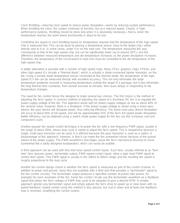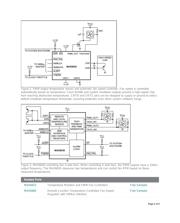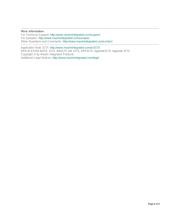herunterladen

Maxim > Design Support > Technical Documents > Application Notes > Automotive > APP 3173
Maxim > Design Support > Technical Documents > Application Notes > Temperature Sensors and Thermal Management > APP 3173
Keywords: MAX6653, MAX6660, MAX6620, MAX6639, fan control, cooling, high-speed chips
APPLICATION NOTE 3173
Automatic Fan Control Techniques: Trends in Cooling
High-Speed Chips
By: Kerry Lacanette
Jul 08, 2004
Abstract: Cooling fans are an important part of thermal management for high-power chips (such as CPUs,
FPGAs, and GPUs) and systems. Unfortunately, their use can sometimes raise a system's acoustic noise level
to the point where it is objectionable to the user. By measuring temperature and adjusting fan speed
accordingly, the fan's speed (and noise level) can be minimized when temperature is low, but increased under
worst-case conditions to prevent damage. This article describes two techniques for automatically controlling a
cooling fan's speed.
High-speed chips tend to run hot. As they get faster, they get hotter. New generation high-speed digital chips
use smaller processes that allow the supply voltage to be reduced, which helps somewhat, but the number of
transistors increases faster than the supply voltage decreases. Power levels, therefore, continue to rise.
As chip temperature increases, performance can suffer. Parameters shift, maximum operating frequencies
decrease, and timing can fall out of specification. From the user's point of view, the product is no longer
operating properly when this occurs. The first reason for cooling high-speed chips, therefore, is to maintain
good performance for the longest possible operating time and over the widest possible range of environmental
conditions. The maximum allowable temperature for a high-speed chip to meet its parametric specifications
depends on the process and how the chip is designed (how "close to the edge" the chip is operating), among
other factors. Typical maximum die temperature values range from +90°C to +130°C.
Beyond the point where performance degradation begins, excessive die temperature causes catastrophic
damage to chips. The maximum die temperature limit is usually well over +120°C and depends on such
factors as process, package, and duration of high-temperature conditions. High-speed chips are, therefore,
cooled to avoid reaching a temperature that could both degrade performance and cause irreparable damage.
A single cooling technique is rarely used with high-speed chips. Instead, combinations of techniques are
generally necessary to ensure high performance and continued reliability. Heat sinks, heat pipes, fans, and
clock throttling are commonly employed to cool high-speed chips. The last two, fans and clock throttling, can
help solve the heat problem, but introduce problems of their own.
Fans can dramatically reduce the temperature of a high-speed chip, but they also generate a great deal of
acoustic noise. The noise from a full-speed cooling fan is annoying to some consumers and is also becoming
a target of government agencies concerned about the long-term effects of noise in the workplace. Fan noise
can be reduced significantly by varying the fan's speed based on temperature; the fan can turn slowly (and
very quietly) when temperature is low, and can speed up as temperature increases.
Page 1 of 6








